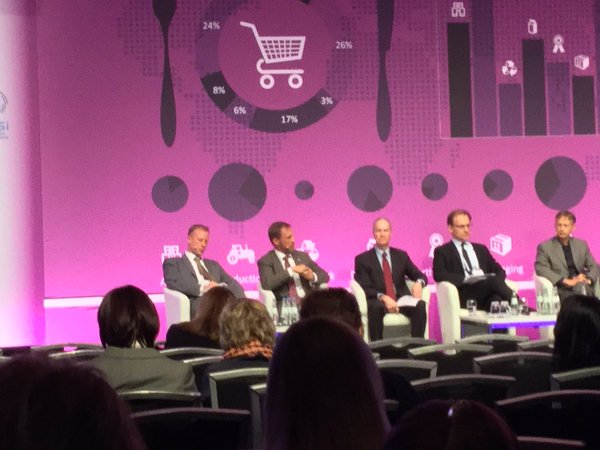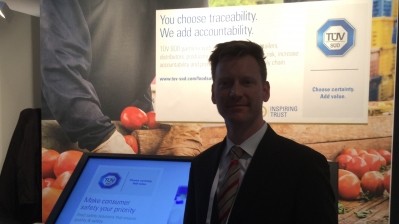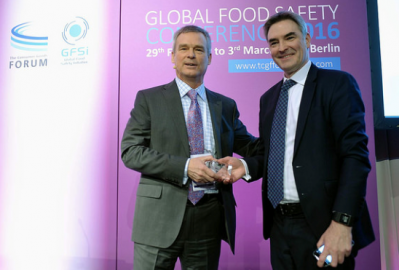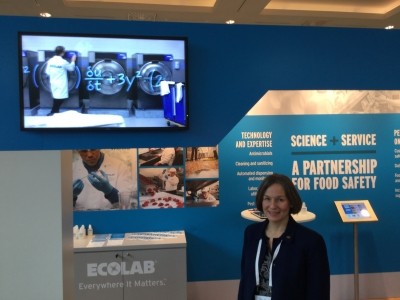dispathces from GFSC 2016 in Berlin
GFSC Day 2 round-up: Globalisation and consumer role

Craig Wilson of Costco and Elena Garcia, associate director of global sanitation at Mondelez International, spoke at an Ecolab breakout session.
Ecolab said food must be safe for consumers no matter where it is sourced, produced and sold and global standards and requirements must be implemented consistently in all facilities.
Garcia said Mondelez has products in 165 countries, uses 3,000 raw material suppliers and 2,000 packaging suppliers.
She said the firm had a food safety program which meets or exceeds regulatory requirements and ensures global consistency.
It conducts internal audits on new suppliers before it starts using them and they must be GFSI certified, with an aim of having all suppliers GFSI certified by next year.
Mondelez does certificates of analysis (COA) verification for sensitive ingredients, to verify raw packaging material and has a material monitoring program to test for things such as mycotoxin and heavy metals.
Garcia said it has company-wide management of issues to minimise the impact before it becomes a problem and as soon as a situation is closed it is important to learn from it.
Costco approach
Craig Wilson said Costco’s guiding premise is that prevention is much easier than any of the alternatives faced in the food safety world.
He identified a five legged stool: food safety training, food safety operations, quality assurance, food safety audits and working with regulations which change from city to city.
“Food safety efforts should be completely invisible to our members,” he said
Wilson said it is not a blind buyer and has specifications for what it buys so it does not matter if it is from Japan, Germany or South Africa if specifications are being met.
Not all of its supply chain is GFSI certified and it was not a requirement as it works with many small suppliers who can’t afford it, he added.
When there is an issue it has the capability to contact 1.8 million people per hour via phone call or text, said Wilson.
The first thing is to stop sale of the item which can be done in 30 seconds globally and it can have a message to all buildings to pull the product off the floor within one hour.
Wilson said in risk communication there is nothing more important than showing it has done all it could adding it don’t believe sticking a sign up saying ‘this was recalled yesterday’.
Parallel sessions on different subjects were held by DNV, Sealed Air Diversey and Greenfence.
Harmonise regulations
Thoughts on harmonising global trade regulation were part of a panel debate including Sebastian Hielm senior food standards officer, joint FAO/WHO food standards programme, Lorenzo Terzi, head of unit DG SANCO G7, bilateral international relations at the EU Commission, Mark Burgham, senior director of programme policy division, CFIA, Melvin Speij, counsellor at WTO and Donald Prater, director FDA Europe.
Hielm said he didn’t see bilateral trade agreements as a threat as most standards refer to Codex and WTO so there was not a sense of competition.
Bilateral trade such as TTIP was a good opportunity to align the regulatory texts of the US and EU to Codex, he added.
Hielm said Codex has a lot of member states and it makes decisions based on consensus, so standard setting can be slow. However, with the issue of melamine, which came out of the blue, all stakeholders wanted to solve it which was an environment that was easy to work in.
Burgham said private assurance schemes can contribute to food safety in the supply chain.
Variables such as intensity, frequency and focus are adjusted in terms of regulatory oversight and the agency takes into account all private accreditation schemes.
Burgham said it has criteria and a process to ensure certification is worthwhile with the details still being worked out but it will publish this at a later date.
Prater said TTIP has completed round 12 and expects to conclude talks by the end of the year.
He said consumers on both sides have high food safety standards and these are already some of the highest in the world.
Prater said regulatory approaches are similar in many aspects but in a few areas they appear different – both have the aim to protect public health but they have gone about doing it in different ways.
Consumer trust
Neil Marshall of the Coca-Cola Company said it believes that greater transparency and traceability is the answer to consumer trust.
He said trust is multi-dimensional with digital communication more important for industry and the consumer, and the firm knows the importance of engagement with consumers and actively taking part in dialogue with them.
Marshall explained about a tool called “The Hub” which was started with a base in Atlanta in 2013 to do social media monitoring on all platforms and look for information on its brands.
He said they have stations in different countries to see what is happening and when, as they have plants working 24/7 and consumers always have a problem somewhere.
Puffer fish findings case study
John Carter, now of Danone, presented an issue of pufferfish being found when he was at supermarket Metro Cash and Carry in Germany and described it as a ‘near miss’.
He said they were told it was monkfish but it was actually pufferfish and while the wrong species of fish can happen in industry with fillets being very similar, pufferfish is poisonous.
Carter said customers were contacted as it knew who they were and a public recall conducted, it also issued a RASFF notice but no consumer illness was reported.
The incident caused a rethink at the firm and it found the product came from Senegal.
Carter talked about traceability programs – with GS1 – being expanded so it knows where products are on every shipment and investment in areas such as rapid DNA testing which gives results in hours compared to other methods which involve waiting for three days - which is not effective as the fish would have been eaten.
He said they made a decision after this happened to share the information and called on industry to have the ‘courage’ to share and use GFSI as a vehicle to communicate.
Food fraud tools
Quincy Lissaur, executive director SSAFE, gave examples of Ahold USA, Kerry Foods and PURO Colombia using its food fraud assessment tool.
Neils Lucas Luijckx presented a system called ERIS from TNO which looks at risk mitigation and Michelle Lees presented on analytical techniques through client Luc Horemands, quality director of private label foods and HPC at E. Leclerc.
GFSI is also releasing a revised version of its Guidance Document (v7) under the name ‘GFSI Benchmarking Requirements’ with the first part being published in parallel to the conference.
The document defines food safety management and underpins GFSI’s benchmarking process, which harmonises the requirements of such schemes and is revised to reflect best-practice and needs in the industry.
Each part of the food supply chain will now have a tailored document dedicated to it.


















